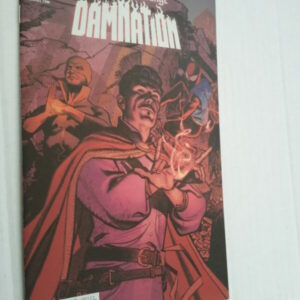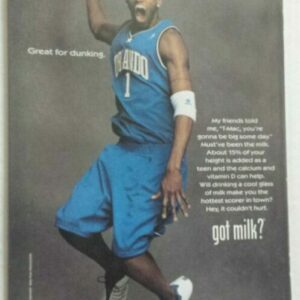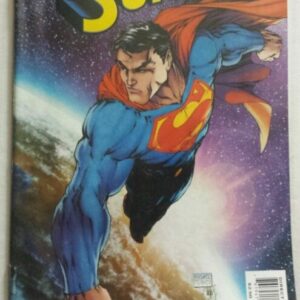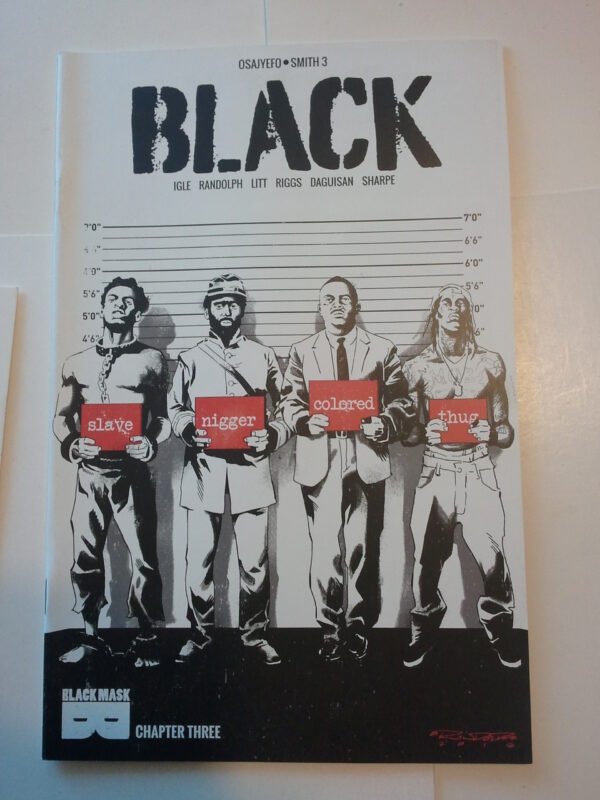Black # 3 NM Black Mask Comics Kwanza Osajyefo Tim Smith 3 1st pr Cover B Movie
$114.99
Description
BLACK #3 uncensored cover
created by Kwanza Osajyefo & Tim Smith 3
written by Kwanza Osajyefo
designed by Tim Smith 3
illustrated by Jamal Igle
lettered by Dave Sharpe
covers by Khary Randolph
edited by Sarah Litt
SOLD OUT!
In the aftermath of Cole’s incarceration, Kareem is beginning to doubt Juncture’s leadership. Meanwhile, the MANN CO. fends off an attack from a terrorist organization. Detective Waters may have finally received the clue she needs to tie together Kareem’s disappearance with her investigation.
Black was created by Kwanza Osajyefo and Tim Smith 3 who, as Osajyefo put it in a statement, were inspired by “experiencing the lack of representation in comics publishing and how that directly relates to the scarceness of black characters.
“For most of comics’ history, white outcasts have been used as allegories for marginalised groups while claiming to reflect the world outside our window. BLACK strips away this veneer to juxtapose superpowers with race while allowing black people to see ourselves authentically in media and inviting wider audiences into parts of our experience.”
Here’s a fun fact if somehow you hadn’t already heard: the story of the X-Men functions as a metaphor for disenfranchised minorities and the struggle for equality. Don’t believe me? Just ask Stan Lee—he’ll be the first one to tell you that’s what he and Jack Kirby intended to create back in 1963. Marvel’s flagship team of mutated humans has always functioned as a misadjusted if well-intentioned analog for the lived experiences of minorities and the very real challenges of structural and institutional racism. Though much has changed in the world of mass publishing since those heady days of the Civil Rights movement, people of color remain a marginalized population within the mainstream comic book industry and as such, stories involving minority characters told from perspectives that speak with personal, authentic insight into the dimension of those lives remain scant—if present at all. That’s what Black, co-created by former DC editor Kwanza Osajyefo and designer Tim Smith 3, hopes to fix, creating a canon of new heroes whose powers are derived from the condition of their blackness.
This issue’s opening scenario is heartbreakingly familiar to anyone who’s followed the news in the past three years: while walking through their neighborhood on their way to play basketball, 15-year-old Kareem Jenkins and his two friends are mistaken for armed burglars and held at gunpoint in a heated police stand-off. In a tragic hair-trigger moment of flight or fight, the three young men are gunned down in broad daylight. Miraculously, Kareem survives, escaping confinement only to be rescued from police pursuit by mysterious benefactors with an intimate understanding of his plight. Kareem is one of the gifted 0.5 percent of black people with a rare hereditary condition which bestows tremendous superhuman abilities yet unknown to the rest of the human race. Now it’s up to Kareem, with the help of his mentors, to discover and hone his powers to protect himself and those like him from the malicious forces that seek to suppress this knowledge at all costs.
Black’s premise is charged with political relevancy, to say the least. In a calendar year that’s seen the deaths of over 201 black people at the hands of police force, with resulting riots, protests and demonstrations from the likes of community organizations and groups including Black Lives Matter and the American Civil Liberties Union, Black is an example of art born inextricably from the times in which it was created. As the discourse surrounding the magnification, appropriation, examination and extinguishment of black life in recent years has grown to assume center-stage in the cultural consciousness, the presence and conveyance of the black experience within popular culture have seldom been more essential or contested. For this reason alone, Black is admirable not only for its contribution to the visibility of the contemporary black experience within the realm of graphic storytelling, but also for providing a fictional form of catharsis from a very real and present fear that pervades the black experience in our present day. It asserts in no uncertain terms that not only does black life matter—it is indisputable in its resiliency.
That said, the series’ first issue runs into some disappointing structural issues and leaves something to be desired. In the phenomenon of police shootings, those who read or hear about such cases only have the opportunity to know the victims in the past tense, their lives framed by the tragic circumstances of their death. This too can be said of Kareem, the comic’s protagonist who exists for all but three pages before he’s annihilated by gunfire.
To indulge a tangent: comic readers have the privilege of knowing who Peter Parker was before the fateful spider bite that transformed him into New York’s neighborhood webslinger. A science nerd, the adopted son of a loving aunt and uncle, a photographer who pined for the affections of the most popular girl in school. As of this issue, we know nothing of the person Kareem was before having been shot, and as a result, his entire existence, and subsequent exceptionality, is solely defined by this one fatal instant. It’s unfortunate that we don’t spend more time in the life and headspace of Kareem before his fateful death, to know him and the makings of the hero that he is likely to become through words and deeds, instead of being told after his posthumous transformation.
The issue’s pacing speeds forward, shuffling Kareem from impromptu resurrection to frantic foot chase to a plot point that none-too-subtly pays homage to an iconic scene from The Matrix. Black #1 reads as though it’s in a breathless hurry to establish its core concept—at the unfortunate cost of forgoing background on the issue’s principal characters and, in most cases, neglecting to even introduce their names. At most, they exist as archetypes now: the mysterious mentor, the sage-like matriarch, the hulking hired help and the devious chief conspirator. Such details are likely slated to be introduced piecemeal throughout the story’s arc, no doubt, but it’s pretty damning to read through an entire full-length issue and know the names of, at most, only three characters. Industry veteran Jamal Igle’s artwork, working from designs by Smith 3, is a saving grace of the comic, with clean linework, well-composed frames and great facial expressions. The use of monochromatic tones and shading is an interesting choice in 2016, but artist Sarah Stern more than delivers on her duties.
The authors behind Black have tapped into a raw and potent vein of inspiration and there’s no doubt to the drive, creativity and ambition in which they’ll see Kareem’s journey through to its conclusion. The first issue has its…issues…that are likely owed to the story being better suited as a graphic novel or collected edition than as a serial, but nothing so negative that it should dissuade prospective readers excited to give this timely series a shot.
“BLACK follows Kareem Jenkins, a young black teenager who gets racially profiled and gunned down by police only to discover that he is one of many black people with superpowers.”
-Comics Alliance
“Amid the usual fisticuffs of superhero comics, BLACK makes room for commentary.”
-The New York Times
“There is, unfortunately, no better time for a comic book like BLACK to be announced and created than right now, because the visual of the young Black man wearing a hoodie and being confronted by the gun(s) of police officers is burned into our collective conscience. It is the image of one of the most prevalent and gross generalizations of our times.”
-Comic Book Resources
Kwanza Osajyefo And Tim Smith 3’s ‘Black’ Is Heading To The Big Screen
EXCLUSIVE: Studio 8 announced this morning that Warner Bros. has acquired Black, the feature adaptation of the Black Mask comic series from co-creators Kwanza Osajyefo and Tim Smith 3. The comic sets out to explore a universe where only Black people have superpowers beyond what the world believes is possible.
Bryan Edward Hill, who is a producer on DC’s Titans, wrote the script. The story centers on one young man who survives a violent event and realizes that he is part of these extraordinary people, but a secret consortium wants to control these abilities and those who possess them, and he soon finds himself at the center of a war over the future of mankind itself.
Jeff Robinov, Guy Danella, and John Graham will produce from Studio 8 with Black Mask Studio’s Matteo Pizzolo and Brett Gurewitz to serve as producer and executive producer. Osajyefo and Smith are co-producers as well. The team is currently looking to attach a director.
Osajyefo came up with the concept for the comic over a decade ago and it gained widespread recognition after its Kickstarter campaign raised over $90,000. Black has launched an entire universe of comics and books. Original artists and writers of the comic and its spinoffs include Jamal Igle, Khary Randolph, Jennifer Johnson, Vita Ayala and Liana Kangas.
“Part of the inspiration for Black came from my experiencing the lack of representation in comics publishing and how that directly relates to the scarceness of black characters,” said Osajyefo. “For most of comics’ history, white outcasts have been used as allegories for marginalized groups while claiming to reflect the world outside our window. BLACK strips away this veneer to juxtapose superpowers with race while allowing black people to see ourselves authentically in media and inviting wider audiences into parts of our experience. We’re excited to bring this story to everyone through film, and thankful to Studio 8 for believing in it.”
“We became involved in the development of this story over a year ago,” said Studio 8 CEO Jeff Robinov. “Black represents a new generation of storytellers and creators who can accurately tell black stories with the type of care the industry has lacked for decades. The thought-provoking concept caught our attention early on, and we’re proud to play a role in bringing this story to the screen”.
Near mint, 1st print. Bagged & Boarded.
Related products
-


Transformers Till All Are One Revolution 1 Subscription Cover B Blank 1st print
$64.99 Add to cart -


ROM # 1 NM IDW 1st print Christos Gage Chris Ryall Art Deco Whalen SubscripCvr
$47.99 Add to cart -


Doctor Strange Damnation 1 NM Variant Connecting Cover Smallwood Multiverse Mad
$89.99 Add to cart -


Superman 205b Michael Turner Variant Cover Azzarello Jim Lee Art 1st print
$32.99 Add to cart

